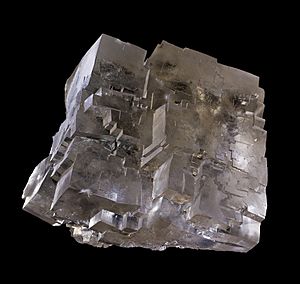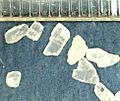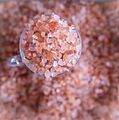Salt facts for kids
In chemistry, a salt is a special kind of chemical compound. It is made when positive particles called cations join with negative particles called anions. These particles are also known as ions. The most common type of salt that you know is table salt, which is also called sodium chloride.
When salts are mixed in water, they create something called an electrolyte. Electricity can travel through electrolytes, and also through salts that have been melted.
Salts can help melt ice. This is because they make the temperature needed for water to freeze much lower. That's why you sometimes see salt spread on roads in winter when it's just a little bit cold.
Contents
What is Table Salt?
- See also Table salt
When most people say "salt," they are talking about 'table salt' or 'edible salt.' This is the salt you can eat! It is mostly made of a chemical called sodium chloride (NaCl). Salt is one of the few minerals that humans eat a lot. But it's used for more than just making food taste good.
There are different kinds of edible salt. Some are unrefined, like sea salt. Others are refined, like the table salt you find in shakers. There's also iodized salt, which has added iodine. Salt is a crystal that can be white, light pink, or light gray. We usually get it from sea water or from rock deposits deep underground. Natural sea salt often has tiny bits of other minerals mixed in. Rock salts can look a bit grayish because of these extra minerals.
Sodium (Na) and chlorine (Cl) are the two elements that make up sodium chloride. Both of these elements are important for all living things, including us! However, we don't always get them from eating a lot of salt. For example, some groups of people, like the Yanomami tribe in South America, eat very little salt. Salt helps control how much water is in our bodies. The taste of salt is also one of the main tastes we can sense. If your body needs more minerals like sodium chloride, you might crave salty foods.
Eating too much salt can sometimes lead to health problems, like high blood pressure. In cooking, salt is used as a preservative. This means it helps food last longer. It's also used as a seasoning to add flavor.
Here are some ways we get table salt:
- From the sea, using special areas called salt evaporation ponds or desalinisation plants.
- From mountains or underground, by digging in salt mines.
- From natural salty water, called brine.
- From the supermarket, where it's already processed and packaged.
A Brief History of Salt
Salt has been used to keep food fresh for a very long time. This is because many tiny germs cannot live in salt. Using salt to preserve food helped people store large amounts of food. They could also send food far away and eat it all year long. This helped more people live in one place, allowed cities to grow, and made it possible to feed soldiers during wars.
People probably started using salt in Egypt as far back as 4000 BC. In ancient times, salt was much more valuable than it is today. It was hard to get in many places. It was used to make food taste better and to make it last longer. Salt allowed food to be kept past its normal season and taken on long journeys.
People often traded salt for other goods. It was very important in China, Turkey, the Middle East, and Africa. In the Mediterranean area, including Ancient Rome, salt was even used as money! The word salary comes from the Latin word for salt. This is because people were sometimes paid in salt. After people learned how to get salt from the ocean, salt became cheaper. The Phoenicians were some of the first to figure out how to do this. They would pour seawater on dry land. When the water dried up, they collected the salt and sold it.
Salt was also used in war as a way to punish a city. Soldiers would spread salt on the land to ruin the city's crops. This was called "salting the Earth." The Assyrians are believed to have done this to their enemies.
What Salt Looks Like
Colors of Salt
Salts can come in many different colors! For example:
- Yellow (like sodium chromate)
- Orange (like potassium dichromate)
- Red (like mercury sulphide)
- Mauve (like cobalt chloride hexahydrate)
- Blue (like copper sulfate pentahydrate)
- Green (like nickel oxide)
- Colorless (like magnesium sulphate)
- White (like titanium dioxide)
- Black (like manganese dioxide)
Most minerals and many colors used in paints are actually salts.
Images for kids
-
Halite (rock salt) from the Wieliczka salt mine, Małopolskie, Poland
-
Loading sea salt at an evaporation pond in Walvis Bay, Namibia; halophile organisms give it a red colour
-
Salt production in Halle, Saxony-Anhalt (1670)
-
Ponds near Maras, Peru, fed from a mineral spring and used for salt production since pre-Inca times.
-
SEM image of a grain of table salt
-
Comparison of table salt with kitchen salt. Shows a typical salt shaker and salt bowl with salt spread before each on a black background.
-
Irregular crystals of sea salt
-
Himalayan salt is halite with a distinct pink color
-
Two men with stacks of rock salt in Bamyan, Afghanistan
-
Sea salt evaporation pond at Walvis Bay. Halophile organisms impart a red colour
-
Bread and salt at a Russian wedding ceremony
See also
 In Spanish: Sal común para niños
In Spanish: Sal común para niños















